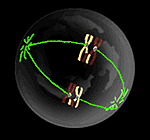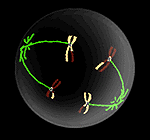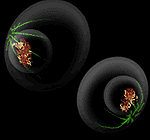Mitosis
What is (and is not) mitosis?
| Mitosis is nuclear division plus cytokinesis, and produces two identical daughter cells during prophase, prometaphase, metaphase, anaphase, and telophase. Interphase is often included in discussions of mitosis, but interphase is technically not part of mitosis, but rather encompasses stages G1, S, and G2 of the cell cycle. |
Interphase & mitosis Interphase
 |
The cell is engaged in metabolic activity and performing its prepare for mitosis (the next four phases that lead up to and include nuclear division). Chromosomes are not clearly discerned in the nucleus, although a dark spot called the nucleolus may be visible. The cell may contain a pair of centrioles (or microtubule organizing centers in plants) both of which are organizational sites for microtubules.
|
Prophase
 |
Chromatin in the nucleus begins to condense and becomes visible in the light microscope as chromosomes. The nucleolus disappears. Centrioles begin moving to opposite ends of the cell and fibers extend from the centromeres. Some fibers cross the cell to form the mitotic spindle.
|
Prometaphase
 |
The nuclear membrane dissolves, marking the beginning of prometaphase. Proteins attach to the centromeres creating the kinetochores. Microtubules attach at the kinetochores and the chromosomes begin moving.
|
Metaphase
 |
Spindle fibers align the chromosomes along the middle of the cell nucleus. This line is referred to as the metaphase plate. This organization helps to ensure that in the next phase, when the chromosomes are separated, each new nucleus will receive one copy of each chromosome.
|
Anaphase
 |
The paired chromosomes separate at the kinetochores and move to opposite sides of the cell. Motion results from a combination of kinetochore movement along the spindle microtubules and through the physical interaction of polar microtubules.
|
Telophase
 |
Chromatids arrive at opposite poles of cell, and new membranes form around the daughter nuclei. The chromosomes disperse and are no longer visible under the light microscope. The spindle fibers disperse, and cytokinesis or the partitioning of the cell may also begin during this stage.
|
Cytokinesis
 |
In animal cells, cytokinesis results when a fiber ring composed of a protein called actin around the center of the cell contracts pinching the cell into two daughter cells, each with one nucleus. In plant cells, the rigid wall requires that a cell plate be synthesized between the two daughter cells.
|
mitosis in real time
MeiosisWhat is meiosis I? | In meiosis I, chromosomes in a diploid cell resegregate, producing four haploid daughter cells. It is this step in meiosis that generates genetic diversity. |
The phases of meiosis I & II Prophase I
 |
DNA replication precedes the start of meiosis I. During prophase I, homologous chromosomes pair and form synapses, a step unique to meiosis. The paired chromosomes are called bivalents, and the formation of chiasmata caused by genetic recombination becomes apparent. Chromosomal condensation allows these to be viewed in the microscope. Note that the bivalent has two chromosomes and four chromatids, with one chromosome coming from each parent.
|
Prometaphase I
 |
The nuclear membrane disappears. One kinetochore forms per chromosome rather than one per chromatid, and the chromosomes attached to spindle fibers begin to move.
|
Metaphase I
 |
Bivalents, each composed of two chromosomes (four chromatids) align at the metaphase plate. The orientation is random, with either parental homologue on a side. This means that there is a 50-50 chance for the daughter cells to get either the mother's or father's homologue for each chromosome.
|
Anaphase I
 |
Chiasmata separate. Chromosomes, each with two chromatids, move to separate poles. Each of the daughter cells is now haploid (23 chromosomes), but each chromosome has two chromatids.
|
Telophase I
 |
Nuclear envelopes may reform, or the cell may quickly start meiosis II.
|
Cytokinesis
 |
Analogous to mitosis where two complete daughter cells form.
|
Comparing Meiosis and Mitosis - Chromosome behavior
- Mitosis: Homologous chromosomes independent
- Meiosis: Homologous chromosomes pair forming bivalents until anaphase I
- Chromosome number- reduction in meiosis
- Mitosis- identical daughter cells
- Meiosis- daughter cells haploid
- Genetic identity of progeny:
- Mitosis: identical daughter cells
- Meiosis: daughter cells have new assortment of parental chromosomes
- Meiosis: chromatids not identical, crossing over.
In plant cellInterphase
 | Prophase
 | Metaphase
 | Anaphase
 | Telophase

|


















